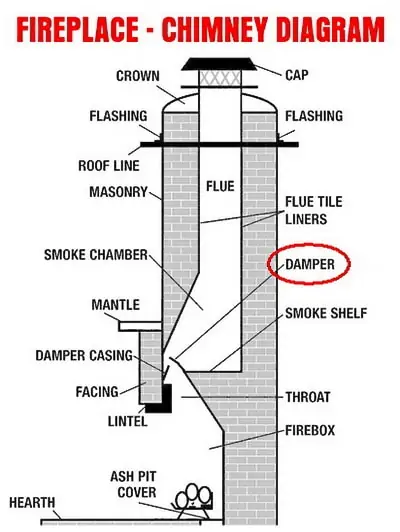For many of us in the Pacific Northwest, the fireplace is one of our favorite spots in the home for the family to get together. We can share stories, play games, or just spend time together by the fire. However, sometimes we may forget about the important parts of a chimney that remain unseen, beyond the hearth of our fireplace. When these components of the chimney are in good working order, they keep our home safe. We want to have a relatively smoke-free environment and one that keeps the harmful residues of soot and creosote out of our homes.
It is helpful to know about the various parts of a chimney in order to keep it clean and efficient. Furthermore, when the chimney maintenance workers come to your home and describe what they are doing, or any potential problems, it’s useful to know exactly what they are referring to. Did you know there might be over seven different parts that compose the anatomy of your chimney? Let’s examine these various parts and their purpose:

- Flue: This is a duct, vent, or, in some cases, the chimney itself. Its purpose is to transport the gases from the fireplace to the outside of your home. Thus, the flue is a crucial component because these gases can be potentially harmful when the flue isn’t working properly and they come into your home.
- Flue Lining: Safety first! Often, the lining is stainless steel. The lining must be able to withstand very high temperatures without extreme warping. It also must be a material that prevents or retards excessive buildup of soot and/or creosote.
- Chimney Crown: This piece prevents water accumulation in the chimney from precipitation. This is protection for the chimney from deterioration, pieces of the chimney becoming brittle and falling into the fireplace, and the appearance of the chimney. Without the crown, rain and other precipitation can seep into the cracks and break up the structural integrity.
- Chimney Damper: This is a flat, rectangular blade moved by a lever that is pulled open or shut preventing or allowing airflow into the chimney. It is also used to close access to the chimney so that warm air inside the home does not escape and animals do not enter the home via the chimney. It is a good idea to remember to close the chimney damper when your family is not using the fireplace.
- Smoke Shelf: The shelf is located slightly beyond the damper mentioned above. Its purpose is to catch any debris that might fall into the chimney as well as precipitation. It also helps prevent downdrafts.
- Smoke Chamber: It is common for one of the walls of the smoke chamber to be angled to help guide the particles resulting from the fire into the chimney. It is an intermediate area that optimizes airflow for the potentially harmful particles and gases to reach the outdoors.
- Rain Cap Arrestor: Sometimes people describe this as a tiny house that rests on top of your chimney. It is a lid with a mesh screen made of metal. It keeps small animals and rain from going down the chimney. It also helps prevent sparks from exiting the chimney and landing on the shingles of the roof which could be a fire hazard.
As an important part of the anatomy of a chimney, let’s talk about the importance of one of the pieces listed above: the flue.
When a fire is burning in your fireplace, gases are emitted which leave your home by way of the flue. The flue is crucial for proper airflow to expel potentially harmful particles like soot and creosote in addition to the gases. In modern homes, it is almost always necessary to create an airflow with an air intake which is built into the flue. These flues are often called “balanced flues.” It is necessary to double-check that your flue is designed for the size of the room that contains your fireplace and that the air intake is functioning properly. The requirements will be different for each home.
There are three basic types of flues:
- Balanced Flue: (mentioned above)
- Flueless/Vent-Free: A catalytic converter is utilized to clean the combustion gases where they are released into the room. One of the advantages is that the home doesn’t lose its heat through the flue. This type of flue necessitates a larger room so make sure your specifications comply with safety regulations.
- Power Direct Flue: Here, a fan is utilized to take the combustion gases past the flue to the outdoors. The fan functions using an electrical power supply. You can also use a power flue to locate your fireplace at a distance from a nearby external wall.
It is helpful to know the various parts of a chimney and understand their function because there are serious risks if some of these parts are missing or damaged. When you are familiar with the various components, you can speak intelligently with your chimney repair/maintenance person when they come to your home.
The flue, for example, is very important because it expels potentially harmful byproducts from your fireplace to the outdoors. It also keeps the energy efficiency of your home in good standing when it closed and you are not using your fireplace. You can help ensure the safety of your home’s fireplace and chimney by having regular maintenance visits from qualified professionals. This will make your life easier in the long run and give your family peace of mind.
